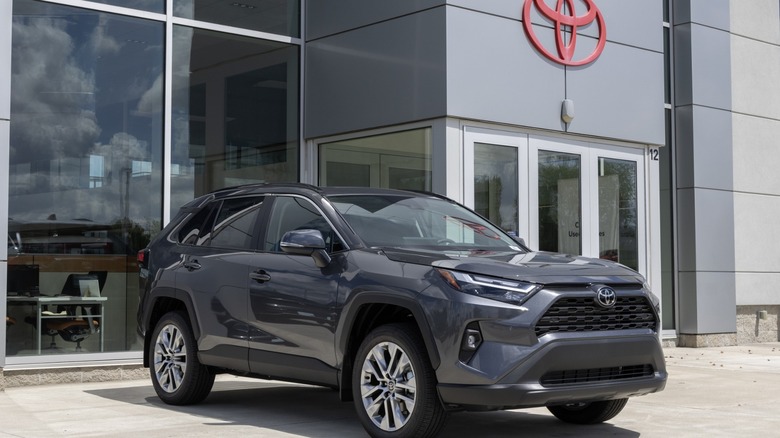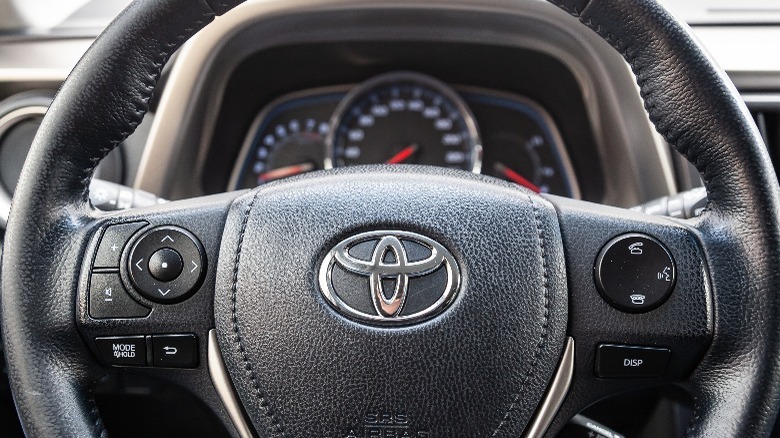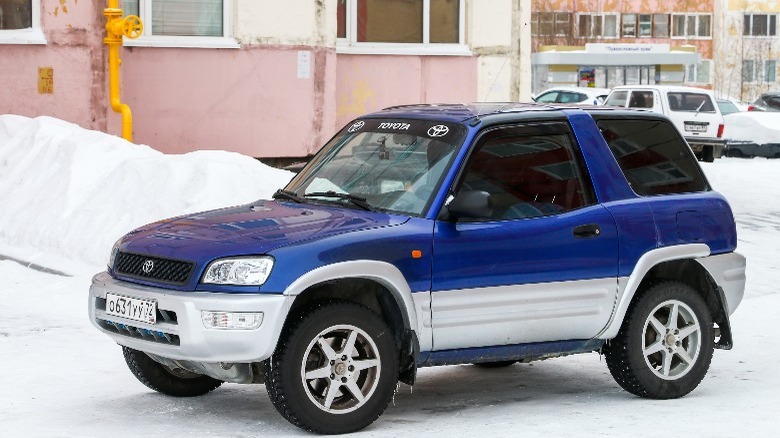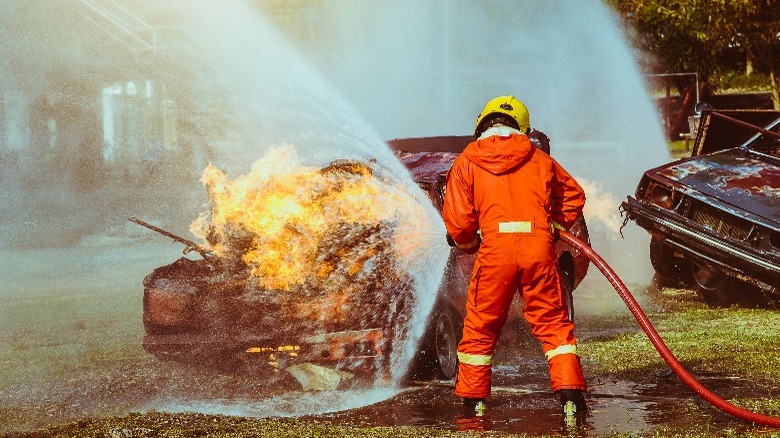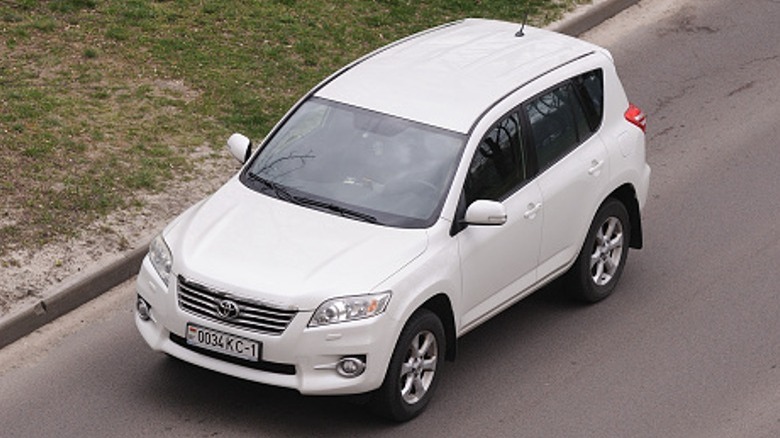Common Problems That Can Happen With The Toyota RAV4
Toyota has stood as the car brand of reliability for decades. The RAV4, first introduced in 1994, holds a high position on the lineup for the most reliable Toyota models ever built. Many also consider the RAV4 one of the most affordable and durable Toyota cars. A car model that has been around this long has seen a lot of refinement over the years. However, although Toyota has adjusted to new car trends with each generation, issues can still linger.
Some of these problems can be avoided with a reasonably regular maintenance schedule. But with more used RAV4s in the market — some with hundreds of thousands of miles on the odometer — some of these hiccups will be unavoidable.
The RAV4's issues include excessive oil consumption, steering wheel problems, lagging transmissions, fuel system problems, and electrical complications, among other troubles. Here, you'll see which RAV4 model years frequently experience what issues and what might cause them. Although, this is not an exhaustive list.
Excessive oil consumption
Third-generation RAV4s start with the 2006 model and end with the 2012. While it was the generation to introduce the optional third-row seating for extra passengers, many 2006-2008 owners complained about how frequently they had to replace the RAV4's oil.
These 2006 to 2008 models have the 2.4-liter 2AZ FE engine in common, an engine widely used in the Camry, Highlander, and Matrix, as well. The main suspect for this engine's oil consumption issue is how the piston ring is designed. The oil control ring (or scraper ring) is typically designed to remove excess oil from the cylinder wall, but the ones in the 2AZ FE do not scrape enough away, resulting in more oil consumption.
Driving an RAV4 from these oil-gulping years after driving an oil-efficient car could cause you to neglect to top up your oil as frequently as you should. Since this might be a piston problem, there's no easy way to fix this issue short of replacing the engine. The best thing to do is check your oil regularly to avoid stressing an unlubricated engine.
Clunking noises while steering and steering difficulties
Some RAV4 owners have complained of strange clunking or clicking noises when attempting to turn the steering wheel. Once again, the 2006-2008 RAV4s are major culprits of this issue, which some speculate to be a result of a defective steering shaft.
It's also common to encounter trouble with the electric power steering (EPS), which could make the steering wheel much harder to turn. In some cases, it might completely freeze up suddenly, making it difficult to steer and more prone to accidents. EPS issues are not unlikely if you use an RAV4 from 2006 or later. These could be caused by electrical issues or water damage. You will see a warning light on your dashboard with a steering wheel and an exclamation point as an indicator.
Since all RAV4s before 2006 used a hydraulic steering system instead of EPS, it simply might be time to change the power steering fluid if you use an RAV4 from 2005 or earlier.
But the newer RAV4s aren't completely blameless in this matter. According to NHTSA (PDF), Drivers in 2019-2021 RAV4s are prone to getting a "pulling" or "drifting" sensation after the car gets soaked. The 2019 RAV4 has especially built a bad reputation as one that could lose electric power steering assistance. Some consider the 2019 RAV4 as one of the most unreliable used Toyotas to avoid.
Transmission lagging or slipping
The 2001-2003 Toyota RAV4s are notorious for transmission issues. In fact, the 2002 RAV4 is one of the worst models for problems with shifting, jerking transmission, and ECM failures.
These problems were so bad that Toyota was forced to extend its warranty from five years-60,000 miles to 10 years-150,000 miles, and coverage for the ECM and transmission. There were other reports of hundreds of cases of transmission failure. However, most of these can be traced to the ECM.
More recently, the 2019 Toyota RAV4 also suffered a similar problem. Many owners have complained of the car's hesitation when they try to accelerate from a slow roll or lower gear. Resulting in lurches when they try to speed up. It's no surprise, though, seeing as that model has seen seven recalls since it was released.
Just like the second-generation RAV4, the likely culprit is the ECM. Take the vehicle to a verified service center and have them reprogram or replace the unit.
Electrical problems and potential battery fire
On November 1, 2023, Toyota recalled some 2013-2018 RAV4s because about 2 million were affected by electrical fire. The most common cause is that the battery could slip out of its tray while driving and come in contact with the hold-down clamp, resulting in a short circuit and a potential electric fire. Consequently, Toyota dealerships must replace the battery tray, battery hold-down bracket, and positive terminal cover at no cost to the owner.
Toyota claims that this fire occurred because of replacement 12-volt batteries. So, if your RAV4 has gotten a replacement battery that is smaller at the top than the original, you might want to be careful that the battery doesn't slip from the tray. You should also watch out for a recall from Toyota by December 3, 2023.
Less severe electrical issues other owners have reported on RAV4s include malfunctioning stereos, infotainment systems, and navigation displays (although this is mostly a poor interior problem). Additionally, many of the previously mentioned electric power steering issues come from an overall bad electric system.
White RAV4s' paint bubbling and peeling off
Compared to the other more life-threatening problems on this list, some paint peeling off your car is a relatively mild problem. However, it doesn't make it any less annoying.
Some RAV4s have built a bad reputation as cars that peel off factory-applied paint, with some owners complaining about the paint job ripping off in sheets. This appears to happen commonly with Toyota cars painted with Toyota's Blizzard Pearl or Super White paint.
The peeling issue arises due to poor adhesion between the paint primer coat and the car's metal. After being exposed to sunlight for some time, paint peels from the exterior metal body panels. Many owners who fixed it themselves reported that a re-priming helped.
Toyota launched a Customer Support Program in 2019 to address this and offered an extended paint warranty. Since the warranty applies to 2008-2017 RAV4s, you can assume these are the most affected models.
